The Waldorf-Astoria is one of New York’s most iconic buildings, but the history behind it is equally captivating. From the frequent star-studded visitors to the family feud that started it all, this is your comprehensive Waldorf-Astoria guide.
A Feuding Origin
If you thought the Waldorf’s beginnings were as poised as the building’s reputation – you would be mistaken. In 1826, the Waldorf-Astor family purchased a number of land parcels that span modern-day Madison and Lexington Avenues. William Waldorf Astor and his aunt, Caroline Lina Webster Schermerhorn Astor would eventually begin to feud.
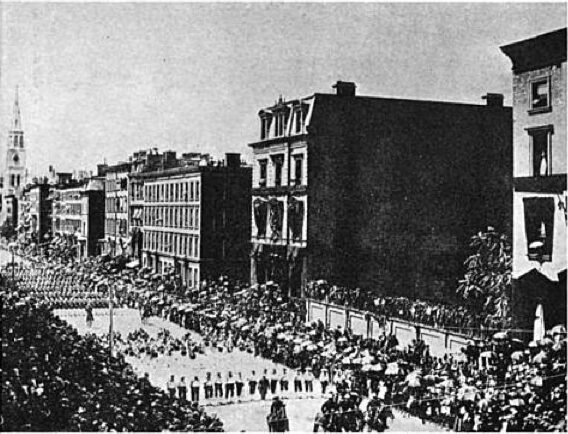
The feud is said to have festered due to the aunt’s elitist socialite behavior but crossed a line when Caroline, who married into the Astor family, wanted to be named the Mrs. Astor after William’s mother died. As the only son of his mother, William believed whoever he married should be considered Mrs. Astor.
These semantics and the longstanding distaste for his aunt forced William to do the one thing anyone does when they have an annoying family member: build a 13-story hotel right next to their house.
The Waldorf
A product of both business prosperity and revenge, the Waldorf opened its doors in 1893.
To help craft up the hotel, William consulted George Boldt, owner and operator of the Bellevue hotel and subsequent Bellevue-Stratford in Philadelphia. The construction and hecticity of a commercial building in a once quiet neighborhood forced Caroline out of her home next door, but more on that later.
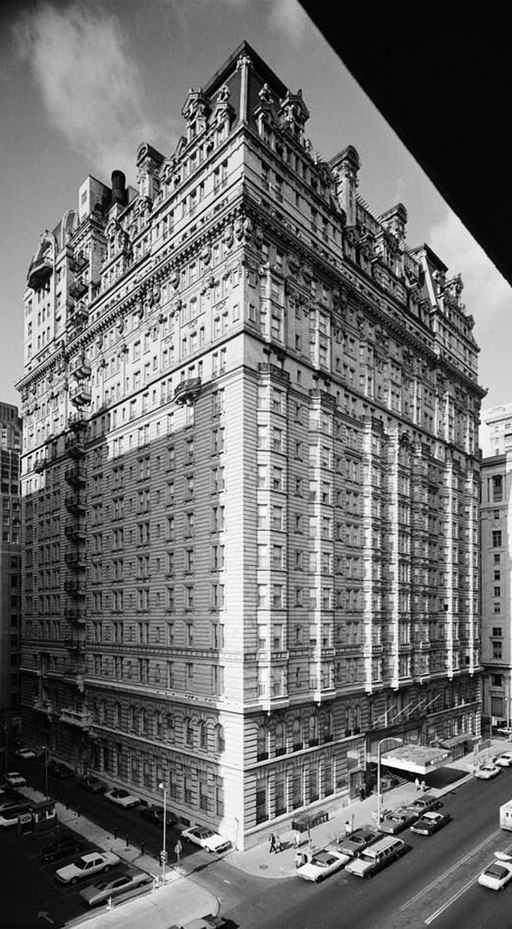
Boldt’s guidance played a huge role in the outcome of the Waldorf, but he wasn’t the only one. His wife, Louise, also played a critical role in the design of the Waldorf, even convincing them to up the floor count from eleven to thirteen – her lucky number.
When all was said and done, The Waldorf tower stood 225 feet tall with 450 rooms for guests. Additionally, there were 15 common spaces, like the ballroom and eateries, plus another 100 rooms reserved exclusively for staff. For decor, the Boldts helped by bringing back a number of European antiques during a trip overseas, adding to the hotel’s decor and, ultimately, its grandeur.
But despite William and the Boldt’s best efforts, the Waldorf was ill-regarded by society upon first opening its doors. Many felt that the Waldorf just didn’t belong in one way or another. New Yorkers didn’t like the hotel in a once quiet neighborhood, while others felt it was too lavish to be in the city.
Just when it seemed doomed, an effort organized on behalf of Boldt helped to solidify Waldorf’s notoriety. On the day after the hotel opened its doors, it hosted a benefit concert for one of New York socialites’ favorite causes, St. Mary’s Children’s Hospital, complete with the New York Symphony Orchestra. That rainy night, with a filled ballroom of New York’s elite and a lovely dinner complete with a full concert (provided for a $5.00 fee), the Waldorf solidified its standing in New York.
More on CitySignal:
News spread, and the Waldorf Hotel quickly became a hotspot for meetings, events, and more. Massive profits even led to an expansion with five additional floors. With expectations being surpassed, it seemed like things would only continue to get better.
At the time, the Waldorf was one of a kind. It was the first hotel to offer electricity and private bathrooms to its guests. Something that, despite all of the gloriousness the hotel had in the form of decor and status, was revolutionary.
But with a feud never laid to rest, Caroline Astor and her son, John Jacob Astor, chose to try their hand at the business.
The Astoria
Caroline Astor’s home was razed, and with the help of her son, they decided to build a hotel next door to the Waldorf – the Astoria. The new hotel, The Astoria, opened its doors in 1897, capitalizing on the success and notoriety that the Waldorf had already gained.
The Astoria offered an alluring novelty that even the Waldorf’s established place had trouble keeping up with. Newer, bigger, better, the Astoria stood at 270 feet, had sixteen stories, provided 550 guest rooms, and took note of both the German and Italian Renaissance styles. Plus, the hotel also had 25 common rooms and a grand ballroom that rivaled the Walford with its alluring Louis XIV style.
The Astoria tower also hosted its fair share of lavish events. The ballroom welcomed great singers like Enrico Caruso and Nellie Melba. Another highlight for entertainment was the tower’s rooftop garden, enclosed with a glass roof and walls.
Eventually, the Astoria was leased to George Boldt, who helped to open the Waldorf hotel years prior. Boldt would go on to help form a sense of peace between the two sides of the family. These efforts would lead to the eventual joining of the two towers forming the Waldorf-Astoria.
Bridging the Two… Becoming the Waldorf-Astoria
A 300-meter bridge, charmingly referred to as Peacock Alley, was built between the two towers to link them. The bridge would go on to symbolize a physical link and represent the joining of the family. The Waldorf-Astoria, building off of the Waldorf Hotel’s initial success, quickly became a New York powerhouse unlike anything before.
Together, the two hotels had a frontage that spanned 200 feet on Fifth and hundreds more feet on 33rd and 34th. And that’s only what met the eye, below the surface was an additional 42 feet of basement and workspace that spanned out toward Broadway.
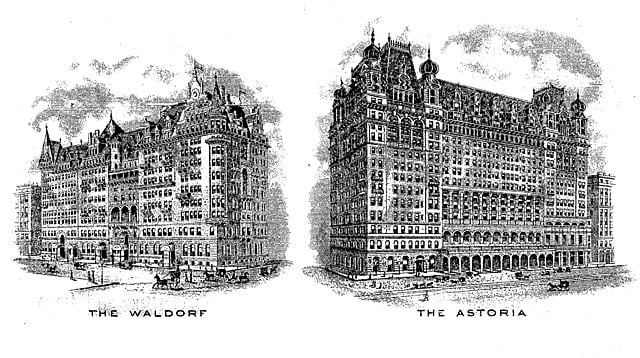
From 1918, the Waldorf was described as “the first of New York’s great “palace hotels” and has always kept the gift of eternal youth. While other hotels have faded and become old-fashioned or dropped out entirely during the quarter century, the big red brick building at 34th Street and Fifth Avenue has maintained its place in the first rank.
The Waldorf never grew old. To out-of-town visitors, it has always stood for the last word in New York hotels. Other more modern and more gorgeous structures have followed it, but none of them has clung that peculiar glamour that surrounded the name – Waldorf-Astoria.”
As New York hotels continued to pop up and the elite social scene spread, the family would inevitably decide to sell to a new group of developers. The hotel closed its doors, and its two towers were taken down. In its spot, another iconic New York building would be built – the Empire State Building.
Founder of Waldorf Astoria Hotel
The complicated history of the Waldorf-Astoria has led many to question who exactly was the hotel’s founder. In the end, the Waldorf Astoria was founded by a few people. Though William Waldorf Astor usually receives the credit, John Jacob Astor and George Boldt also played big roles in what is collectively known as the Waldorf-Astoria brand. Those foundations and the ultimate demise of the original Waldorf-Astoria paved the way for a new reincarnation: The Waldorf Astoria (yes, sans the hyphen).
The Notable Moments and People at the Waldorf Astoria
Just when it seemed the Waldorf-Astor family would be done with the hospitality business, the Waldorf Astoria opened its doors in 1931, only a few years after shutting down the original towers. Located at 301 Park Avenue, the new Waldorf Astoria offered 47 floors of lodging and entertainment.
When finished, the building was the tallest hotel in the world for over 30 years. Despite being in a different neighborhood and a new building, the Waldorf Astoria quickly surpassed the icon status that the original towers once had.
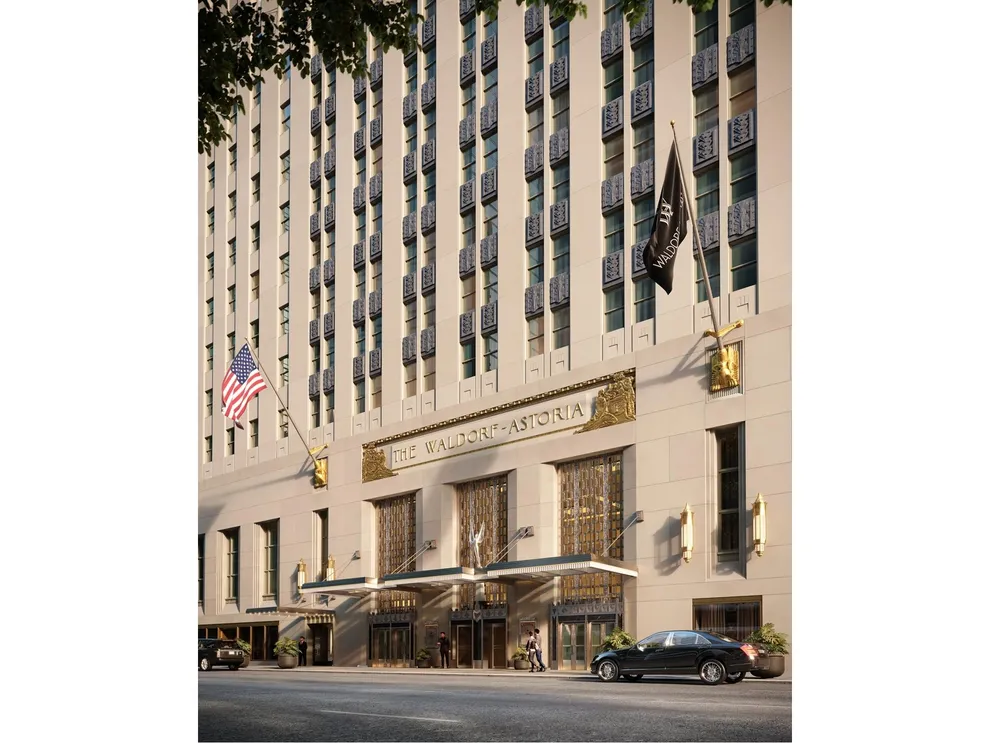
The Waldorf Astoria played a key role in both the lives of the rich and famous and American history. One day it served as a base camp for post-World War II strategizing and the foundation for the World Peace Conference of March 1949, and other times it served as an extended residence for a slew of celebs and high-profile guests.
- Queen Elizabeth II and Prince Philip, who stayed during their first visit to America.
- Herbert Hoover, who resided in his suite for 30 years until his death
- Ava Gardner, Actress
- Elizabeth Taylor, Actress
- Tony Bennett, Singer
- Marilyn Monroe, Actress
- Katharine Hepburn, Actress
- John Wayne, Actor
- Charlie Chaplin, Actor
- Muhammad Ali, Boxer
- Judy Garland, Actress
- Burt Reynolds, Actor
- Frank Sinatra, Singer
It comes as no surprise that the robust guest list came with a few modifications to make guests feel comfortable. One of which is a “secret” railway and car beneath the hotel, known as Track 61.
Some have traced the station to a failed Grand Central Connect, while others have deemed it a loading dock or a charming addition constructed for hotel use as a private railway for guests. In any sense, it’s clear that the uniqueness of the Waldorf Astoria goes much deeper than what meets the eye.
President Franklin D. Roosevelt was said to have used the track to get into or out of the hotel unscathed. Another rumor is that famed artist Andy Warhol used the empty platform space for partying.
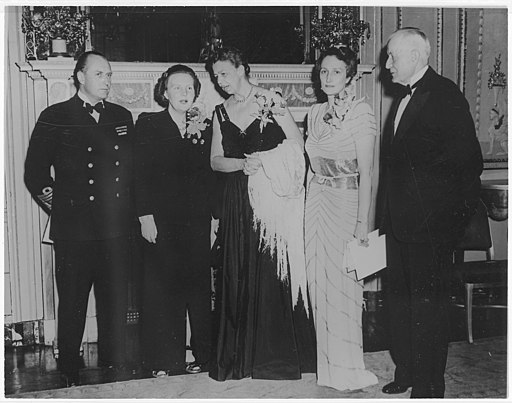
A number of other events took place at the Waldorf Astoria during what was dubbed the “Golden Age” between 1950 and 1963. Highlights include President John F Kennedy’s birthday gala, with admission being $1,000.Then there was Queen Elizabeth II’s Waldorf Astoria visit in 1957, in which her extravagant dinner included South Carolina Green Turtle Soup, Long Island Striped Bass, and more – all finished with a fine cup of Haitian coffee.
Inside and out, the building quickly rose to palace status. Those who hadn’t been to the new Waldorf Astor scheduled a visit, and those who had planned prompt returns. It was the place to be. The notoriety led to slogans like “the vertical Beverly Hills,” or being the place to see or be seen; it’s no wonder the hotel has managed to stay paramount, even in a sea of New York competition in the city.
The Waldorf Astoria Today
The Waldorf Astoria on Park Ave celebrated 90 years of being open, and today, the Waldorf Astoria continues to attract high society and has earned a coveted spot in pop culture. With movies and TV shows being shot at the hotel, including popular New York shows like Law and Order or Sex and the City, those who may not ever consider stepping place into the Waldorf Astoria still have familiarity with the building.
The Current Waldorf Astoria Owner (& Ownership History)
The building has changed hands only a few times since opening, most notably when the Hiltons purchased the property – to which the family has shared their experience being raised in the hotel – but also the recent sale to a Beijing-based company Anbang Insurance Group, with parent company Dajia Insurance Group Co.
However, one of the chairmen involved in Anbang’s operations was being investigated by the Chinese government, who seized the company assets and effectively took on overseeing things like the Waldorf Astoria.
During the Hilton’s ownership, the hotel underwent a slight name change in which the hyphen was changed to a “double hyphen,” or equal sign, which created a representation of the Peacock Bridge. However, the double hyphen would also eventually be dropped as well.
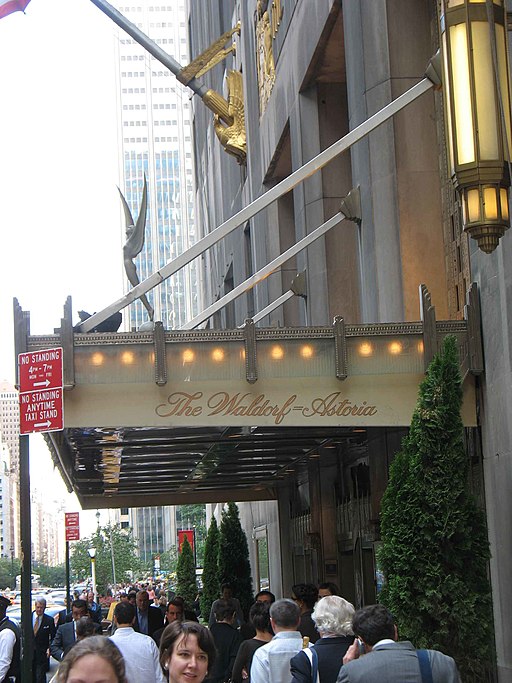
Recent Remodeling of the Waldorf Astoria
Regardless of how the business changes hands, the hotel is somewhat protected as it was deemed a New York landmark. Parts of the interior and exterior are protected under the designation, while other sections are not. This has allowed for the current major remodeling to take place.
When Anabang Insurance Group purchased the hotel, a $1 billion renovation was also planned. That’s nearly ½ of the $1.95 billion purchasing price in renovations alone. But the Waldorf Astoria knows more than anyone else what it takes to remain a leader in the industry. The renovation is slated to bring an update in modernity without losing any of that historic charm.
The design, as carefully curated by interior designer Pierre-Yves Rochon, is “respectful of the hotel’s history on every level, yet we are creating a truly modern place.” Visitors will also find “contemporary furnishings and finishes blend seamlessly with restored materials, creating a continuity between the past and present life of the hotel,” according to Rochon.
Buy at The Towers, Waldorf Astoria Residences
Capitalizing on the trend of extended stays, a new shift in the building’s model is also bringing residential apartments. The new and improved Waldorf Astoria is set to open in 2023, and rather than the 1,400 hotel rooms, it will only have 375 hotel rooms and an equal number of units for purchase.
The residences will also embrace that modern appeal while staying true to the grand nature of the building.
“Each residence celebrates the scale and beauty of the original architecture—a perfect balance of aesthetic and practical considerations—with windows that replicate the building’s original design and flood the rooms with dynamic views of the New York cityscape… the scale and beauty of the original art deco architecture, with its distinctive detailing and set-back terraces, exists in perfect harmony with a contemporary design – blending the old and the new, the cosmopolitan and the American, the grand and the intimate.”
-The Towers
An estimated reopening date of 2024 is expected for the remodel. Want to own a piece of the iconic property? There is still availability for the soon-to-be units! These residences include a studio, one-bedroom unit for $1,895,000 for 561 square feet. The studio unit comes with a “discreet” kitchen, a walk-in closet, and a “gracious” marble entry foyer, among other attributes.
If you need more space, you’re in luck. The Towers offers a four-bedroom, four-and-a-half-bath 2,971 sq ft apartment for $19,000,000, complete with a powder room, a freestanding tub in the primary bathroom, a marble entry foyer, and more.

General amenities include:
- Private, secure entrances (separate from the hotel)
- Porte cochère with valet service on 50th
- 24/7 doorman on Park Ave
- Private residential reception
- Park Ave interior lounge
- 24/7 virtual concierge
- Package and service delivery
- Six residential elevators
- Access to the 25-meter pool
- Private fitness center and wellness rooms
- Gaming room
- Theater
- Winter Garden lounge with bar
- Playroom
- Empire club for exclusive socializing
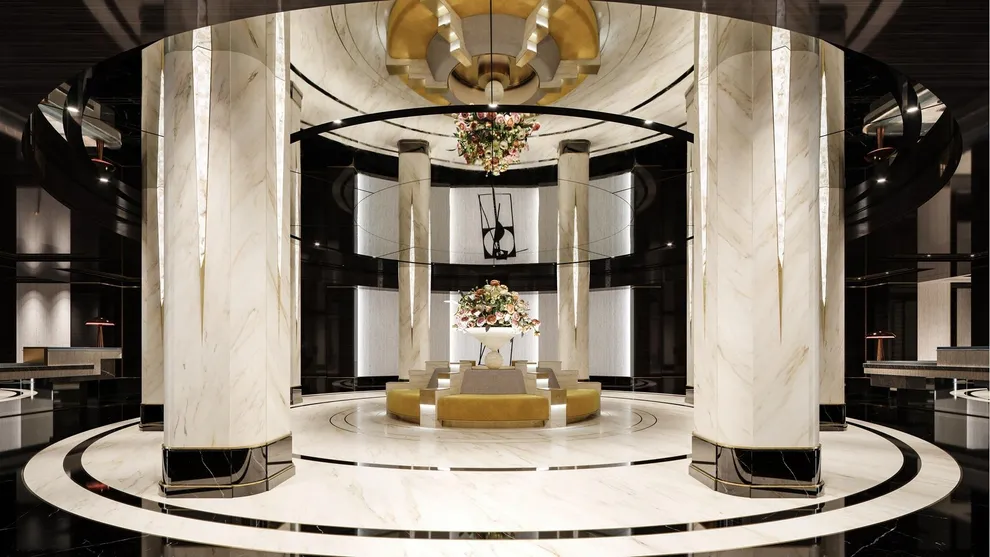
Nearby you can also find The Centrale at slightly lower prices than the Tower Residences.
Experience the Waldorf Astoria Outside of New York
Experiencing the Waldorf Astoria doesn’t require a trip to NYC or a limitless budget, this New York staple is closer than you think. Foods like the Waldorf Salad and Eggs Benedict were all created at the Waldorf Astoria. In large part, this was because of Oscar Tschirky, nicknamed Oscar of the Waldorf, who is credited for the popularization of these dishes and even staples like Thousand Island dressing! If visiting the historic Waldorf Astoria hotel is not at the top of your bucket list, make sure that trying these widespread delicacies are!
Final Thoughts
With deep-seated New York history and unlimited potential, the Waldorf Astoria continues to remain not only relevant but an icon. For many, the discussion of New York as a powerhouse goes hand-in-hand with the history of places like the Waldorf Astoria. Whether you’ve passed by the building on Park Avenue or are familiar with the whispers among elite celebrities and politicians, it’s clear that this hotel continues to remain a leader in the industry, even going on to inspire a chain of luxury hotels in the same name.
Kylee was born and raised just outside of Sacramento in a small town full of history and charm. She stays up-to-date on the real estate market and hopes to empower hopeful buyers and sellers to make the best decisions for themselves. Kylee is particularly interested in bridging the gap for younger generations, helping them understand the power of owning and investing in real estate.



